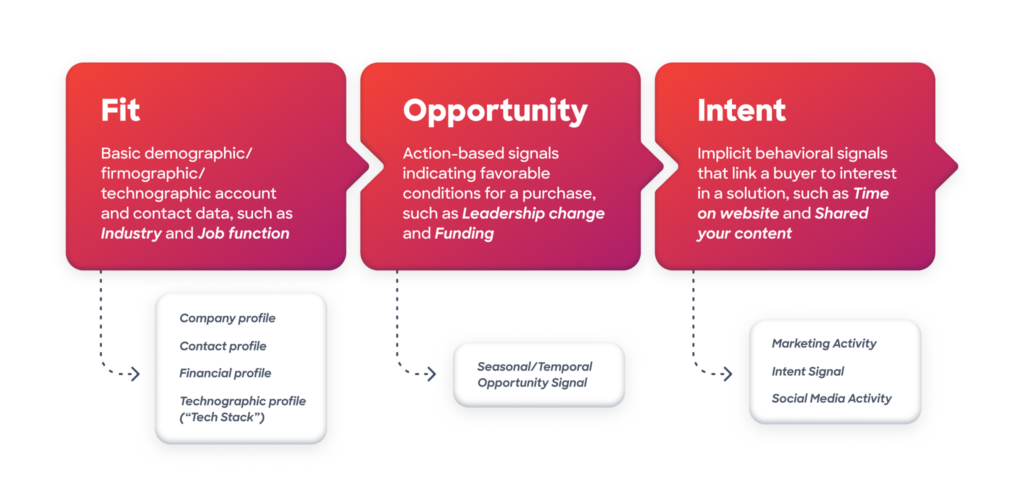What if you could predict a prospect’s next move before they had even considered it?
Thanks to improvements in data collection and machine learning, forecasting customer behavior has become a reality. It’s called predictive intelligence.
Predictive intelligence technology can have a transformative effect on your sales and marketing efforts — but only if it is deployed properly.
To effectively implement this powerful tool, business leaders need a firm grasp of the types of data involved and a clear understanding of how that data fits together. Here’s how to make the most of a predictive intelligence system.
What is Predictive Intelligence?
Predictive intelligence is a type of business intelligence and analysis used to forecast prospect and buyer behavior. It’s a key component of predictive sales intelligence, helping businesses anticipate customer needs and actions.
Predictive intelligence systems often combine historical data, such as customer attributes and information about the buyer’s journey, with real-time market signals, including intent data, regulatory filings, and proprietary research, to suggest good-fit prospects for go-to-market teams.
For sales, predictive intelligence can identify the leads that are most likely to convert, optimize lead scoring, and personalize outreach for improved engagement. Marketing teams can use predictive intelligence to tailor their messaging campaigns and channels, efficiently segment their audiences, and target spending for maximum ROI.
With the right strategy, predictive intelligence helps sales and marketing teams address customer pain points and deliver the right solutions to qualified customers, saving everyone time and money — reducing customer dissatisfaction, churn, and brand damage.
There are three types of data involved: fit, opportunity and intent. Getting to know these data types is essential if you want to unlock the full potential of predictive intelligence.
Why is Predictive Intelligence Important?
By sampling past behavior to predict the future actions and desires of prospects, marketers can use predictive intelligence to deliver a truly personalized customer experience.
Predictive intelligence allows this type of analysis to happen almost instantly. As a result, automated marketing campaigns can deliver the right message at the right time, to the right prospects.
This applies even when a business has thousands of individual prospects, each at various stages of the sales cycle.
The same technology can assist with the human side of marketing and sales, too. Companies can use predictions to create assignment groups, so that every pitch is led by the right person. In turn, this usually means better conversion rates and higher customer satisfaction.
To enjoy such benefits, you need to make accurate predictions. This requires a mountain of high-quality data about existing and potential customers. It also involves identifying the key data points for prediction.
Predictive Intelligence Needs 3 Types of Data
Behavioral information is only predictive when combined with well-defined firmographic data and demographic criteria that fit the ideal customer profile.
The likelihood of purchasing can be measured by combining fit, opportunity and intent data.

Type #1: Fit Data
Fit data is all about the basic requirements: the right contact at the right company.
An identified company profile is an essential starting point for any kind of scoring or predictive analysis. It provides the foundation for the rest of the assessment.
If the company itself is not a great fit, all other information (no matter how effective at prediction) has no value.
Fit data includes basic demographic, firmographic and technographic information at the account and contact level. These include data points such as:
Industry
Job function
Department budget
Technology stack
Location
Use of agencies or contract services
To understand where go-to-market teams are focusing, we previously surveyed more than 200 sales and marketing professionals about 78 predictive data points and combinations of data points.
At the time of our survey, over 85% of respondents said job title was effective or very effective at predicting a prospect’s likelihood of making a purchase.
This is because a job title is a basic, fundamental part of the ideal customer profile. Even if every other piece of the puzzle is perfect, a prospect who lacks purchasing power or is in the wrong department has zero chance of becoming a customer.
Type #2: Opportunity Data
Opportunity insights relate to timing and conditions.
Sometimes a prospect stumbles upon a solution at exactly the moment they need it. In such cases, the decision-making process is straightforward.
More frequently, however, prospects will learn about your solution before they actually need to make a purchase. In some cases, they won’t even have the budget or the necessary pain points to pursue a solution.
That’s why opportunity or “trigger” information becomes a predictive piece of the purchasing puzzle when layered on top of fit and intent data. These are the data points that indicate when conditions are favorable for a change.
They include:
Leadership change
Investment
Pain points
Hiring plans, promotions, layoffs
Company events
Mergers
Regulatory action
In our survey, 84% of respondents said requests for proposal (RFPs) and projects or purchase initiatives were effective or very effective at predicting a prospect’s likelihood of making a purchase.
Overall, just 29% of respondents used fit and opportunity data in combination. Companies in this segment are likely to outcompete their rivals by making better decisions around marketing.
Type #3: Intent Data
The third layer of data that makes up predictive intelligence is intent data.
Intent data derives signals from the activity that links target buyers and accounts to a solution, solution category, or related topics. This includes:
Time on website
Form-fills/content engagement
Competitive or review-based research
Social media activity
The most effective intent data point? Comparing the products of vendors in your category.
In fact, seven of the top eight most effective intent data points in our survey all relate to competitor research and comparison. If a company is comparing vendors in your space — to each other or to your solution — they’re not far from making a purchase. And at that point in the customer lifecycle, the choices have been narrowed down to a small handful.
The information collected by marketing automation systems for a business is one level of intent data, but many teams expand that layer to vast networks of sites and partners that gather intent data from numerous places.
Intent data offers something that fit data can’t provide: it signals interest, demand, or urgency related to a particular topic or need.
Predictive Analytics in Action
While your choice of data is important, predictive intelligence comes from fitting together various data sets to build a complete picture. Here is an example:
Fit: A sales development rep at a company that sells applicant tracking software determines that her best-fit clients are enterprises in the retail industry, which are always hiring due to a high rate of turnover.
Opportunity: The SDR learns that one of her target accounts is opening 23 new stores in her territory, and the Christmas season is just three months away.
Intent: The SDR can see that someone from that same account has visited her company’s website several times, downloaded a datasheet of the integration capabilities of her product, and signed up for a weekly recruitment-tech news round-up. Through third-party intent data, they can also see a recent spike in activity and interest in content related to applicant tracking systems and recruiting.
In combination, these indicators suggest that the account is quite far along in the buyer’s journey — and could respond to outreach that reflects their understanding of the space.
5 Ways to Use Predictive Intelligence in Sales & Marketing
1. Improved Accuracy in Lead Scoring
Lead scoring is the process of ranking the sales readiness of each lead. Marketers score leads based on a set of predetermined criteria, so they can better route, nurture, or sell to them.
The criteria involved in B2B lead scoring may involve data points like industry, company size, or a completed action such as a form submission or content download. Although manual lead scoring can be effective, this method has its flaws.
In part, this is because manual lead scoring relies heavily on assumptions — a lead with the job title of marketing manager might receive a high score, but that doesn’t guarantee they’re qualified or ready to make a purchase.
Predictive intelligence allows for a much more comprehensive approach to lead scoring. For instance, predictive models can now analyze a prospect’s entire digital footprint, from the terms they search to the web pages they visit, and the products they’ve purchased in the past.
Predictive algorithms can also identify patterns within these actions, accurately predict when each lead will be ready to make a purchase, and highlight any further actions that could accelerate the sales cycle.
2. Get Recommendations in Real Time
Visit the homepage of any major e-commerce platform, and you’ll likely find custom recommendations based on previous purchases or searches. This is a perfect example of predictive intelligence at work.
Predictive intelligence allows marketers to create hyper-targeted and dynamic web experiences. When a customer visits a specific page or views a certain item, your site can process this data in real time and offer personalized recommendations based on predefined metrics — dramatically improving the customer experience.
3. Upgrade Your Content Marketing Strategy
Predictive intelligence helps marketers to tailor content marketing strategies to fit the needs and preferences of each prospect. This includes insights into the subjects, tones, and content types that your target customers respond to.
Given the time and energy that it takes to create content, these insights can make your process significantly more targeted and efficient.
4. Improve and Scale SEO
Search engine optimization is a never-ending process of adjustments and reactions. Companies are constantly responding to algorithm changes by search engines, new competitive pressures, internal product launches and priorities, and external market and customer feedback.
One way predictive intelligence systems could help marketers fine-tune their SEO strategies and tactics is by analyzing the most recent campaigns launched by a defined set of competitors, alerting internal teams that more content should be created around a given topic to keep pace.
5. Deliver Better Marketing Emails
One-size-fits-all email campaigns are no longer effective. The best email marketing strategies today are based around personalized messaging, with content that resonates with the actions and preferences of recipients.
The most common example is an abandoned cart email. A customer places an item in their virtual cart and subsequently leaves the page. After a predetermined amount of time passes, the company’s marketing automation platform sends the prospect a follow-up email, reminding them to complete their purchase.
While these messages are based on an underlying template, every aspect is shaped by insights from customer data.
Future Trends in the Predictive Intelligence Landscape
Inevitably, new advances in technology are shaping predictive intelligence. Today, that attention is largely focused on the rise of mass-market generative AI tools like ChatGPT.
Some businesses are now using this technology to reveal deeper insights and provide greater real-time personalization. For example, because powerful generative AI systems are trained to return plain-language answers that humans will accept, it is possible to feed a large dataset to an AI chatbot and have it perform an advanced analysis that finds hidden insights.
Generative AI tools can also be used to advance the drudgery of corporate deal-making at a superhuman pace — ZoomInfo’s Chorus conversation intelligence software, for example, uses generative AI to produce automatically generated post-meeting briefs that derive next steps, concrete findings, and key questions from the transcript of a call or video meeting.
One advantage of this approach is that the insights can be delivered in plain language. This makes it easier for marketers and reps to take appropriate action. It also opens up the possibility of applying predictive insights directly within automated marketing campaigns, with AI-generated messaging providing a personal touch.
Final Thoughts on Predictive Intelligence in B2B Sales and Marketing
As we unpack the proverbial “black box” of predictive intelligence, the most surprising takeaway is that no single data point is a magic bullet.
However, when good fit, opportunity and intent data are properly combined, the potential impact of predictive intelligence is remarkable. Bottom line? Predictive intelligence simply isn’t possible without a rock-solid foundation of B2B data and accurate, timely market signals. ZoomInfo’s unparalleled data across fit, opportunity and intent are the backbone of next-generation, AI-enabled go-to-market strategies — get a demo if you’re ready for predictable revenue that can drive your business to the next level.


